
The Museum of Modern Art (MoMA) is an art museum located in Midtown Manhattan, New York City, on 53rd Street between Fifth and Sixth Avenues.
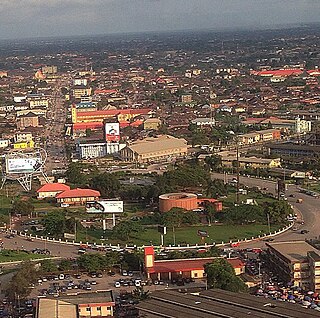
Benin City is the capital and largest city of Edo State, Nigeria. It is the fourth-largest city in Nigeria according to the 2006 census, after Lagos, Kano, and Ibadan. It is situated approximately 40 kilometres (25 mi) north of the Benin River and 320 kilometres (200 mi) by road east of Lagos. Benin City is the centre of Nigeria's rubber industry, and oil production is also a significant industry.
The Benin Expedition of 1897 was a punitive expedition by a British force of 1,200 men under Sir Harry Rawson in response to the ambush of a previous British embassy under Acting Consul General James Phillips, of the Niger Coast Protectorate. Rawson's troops captured and sacked Benin City, bringing to an end the Kingdom of Benin, which was eventually absorbed into colonial Nigeria.

The Oba of Benin is the traditional ruler and the custodian of the culture of the Edo people and all Edoid people. The then Kingdom of Benin has continued to be mostly populated by the Edo.

Fifth Avenue is a major and prominent thoroughfare in the borough of Manhattan in New York City, New York, United States. It stretches north from Washington Square Park in Greenwich Village to West 143rd Street in Harlem. It is one of the most expensive shopping streets in the world.

The American Museum of Natural History is a natural history museum on the Upper West Side of Manhattan in New York City. Located in Theodore Roosevelt Park, across the street from Central Park, the museum complex comprises 20 interconnected buildings housing 45 permanent exhibition halls, in addition to a planetarium and a library. The museum collections contain about 35 million specimens of plants, animals, fungi, fossils, minerals, rocks, meteorites, human remains, and human cultural artifacts, as well as specialized collections for frozen tissue and genomic and astrophysical data, of which only a small fraction can be displayed at any given time. The museum occupies more than 2,500,000 sq ft (232,258 m2). AMNH has a full-time scientific staff of 225, sponsors over 120 special field expeditions each year, and averages about five million visits annually.
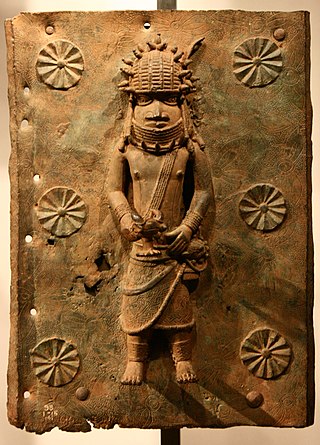
The Benin Bronzes are a group of several thousand metal plaques and sculptures that decorated the royal palace of the Kingdom of Benin, in what is now Edo State, Nigeria. Collectively, the objects form the best examples of Benin art and were created from the thirteenth century by artists of the Edo people. The plaques, which in the Edo language are called Ama, depict scenes or represent themes in the history of the Kingdom. Apart from the plaques, other sculptures in brass or bronze include portrait heads, jewelry, and smaller pieces.

Edo, commonly known as Edo State, is a state located in the South-South geopolitical zone of Nigeria. As of 2006 National population census, the state was ranked as the 24th populated state (3,233,366) in Nigeria. The state population figures is expected to be about 8,000,000 in 2022. Edo State is the 22nd largest State by landmass in Nigeria. The state's capital and city, Benin City, is the fourth largest city in Nigeria, and the centre of the country's rubber industry. Created in 1991 from the former Bendel State, is also known as the heart beat of the nation. Edo State borders Kogi State to the northeast, Anambra State to the east, Delta State to the southeast and southsouth and Ondo State to the west.

2 Columbus Circle is a nine-story building on the south side of Columbus Circle in the Midtown Manhattan neighborhood of New York City. The building fills a small city block bounded by 58th Street, Columbus Circle, Broadway, and Eighth Avenue. It was originally designed by Edward Durell Stone in the modernist style for A&P heir Huntington Hartford. In the 2000s, Brad Cloepfil redesigned 2 Columbus Circle for the Museum of Arts and Design (MAD), which has occupied the building since 2008.

The National Museum of African Art is the Smithsonian Institution's African art museum, located on the National Mall of the United States capital. Its collections include 9,000 works of traditional and contemporary African art from both Sub-Saharan and North Africa, 300,000 photographs, and 50,000 library volumes. It was the first institution dedicated to African art in the United States and remains the largest collection. The Washington Post called the museum a mainstay in the international art world and the main venue for contemporary African art in the United States.

Sir David Frank Adjaye is a Ghanaian-British architect. He is known for having designed many notable buildings around the world, including the National Museum of African American History and Culture in Washington, D.C. Adjaye was knighted in the 2017 New Year Honours for services to architecture. He is the recipient of the 2021 Royal Gold Medal, making him the first African recipient and one of the youngest recipients. He was appointed to the Order of Merit in 2022.

Benin art is the art from the Kingdom of Benin or Edo Empire (1440–1897), a pre-colonial African state located in what is now known as the Southern region of Nigeria. Primarily made of cast bronze and carved ivory, Benin art was produced mainly for the court of the Oba of Benin – a divine ruler for whom the craftsmen produced a range of ceremonially significant objects. The full complexity of these works can be appreciated through the awareness and consideration of two complementary cultural perceptions of the art of Benin: the Western appreciation of them primarily as works of art, and their understanding in Benin as historical documents and as mnemonic devices to reconstruct history, or as ritual objects. This original significance is of great importance in Benin.
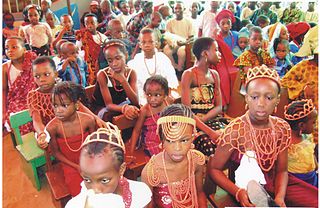
The Edo or Benin people are an Edoid ethnic group, primarily found in Edo State, Southern part of Nigeria. They speak the Edo language and are the descendants of the founders of the Benin Empire. They are closely related to other ethnic groups that speak Edoid languages, such as the Esan, the Afemai, the Isoko, and the Urhobo.
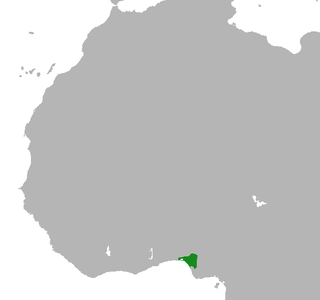
The Kingdom of Benin, also known as the Edo Kingdom or the Benin Empire, was a kingdom within what is now southern Nigeria. It has no historical relation to the modern republic of Benin, which was known as Dahomey from the 17th century until 1975. The Kingdom of Benin's capital was Edo, now known as Benin City in Edo State, Nigeria. The Benin Kingdom was "one of the oldest and most developed states in the coastal hinterland of West Africa". It grew out of the previous Edo Kingdom of Igodomigodo around the 11th century AD, and lasted until it was annexed by the British Empire in 1897.
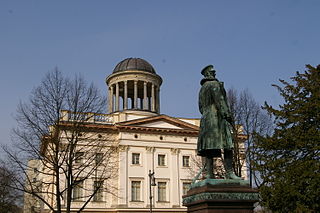
The Berggruen Museum is a collection of modern art classics in Berlin, which the collector and dealer Heinz Berggruen, in a "gesture of reconciliation", gave to his native city. The most notable artists on display include Pablo Picasso, Alberto Giacometti, Georges Braque, Paul Klee and Henri Matisse. The Berggruen Collection is part of the National Gallery of Berlin.

The Benin ivory mask is a miniature sculptural portrait in ivory of Idia, the first Iyoba of the 16th century Benin Empire, taking the form of a traditional African mask. The masks were looted by the British from the palace of the Oba of Benin in the Benin Expedition of 1897.

Peju Layiwola is an art Historian and visual artist from Nigeria who works in a variety of media and genre. She is listed as a "21st Century Avant-Garde" in the book Art Cities of the Future published by Phaidon Press She is currently a Professor of Art and Art history at the University of Lagos and has been described as a "multitalented artist." Her works can be found in the collection of Microsoft Lagos, Yemisi Shyllon Museum, Pan Atlantic, Lagos and homes of private collectors such as JP and Ebun Clark and the Obi of Onitsha.

Okukor is the name given to a bronze statue of a cock from West Africa, held by Jesus College, Cambridge, from 1905 to 2021. One of the Benin bronzes, it was taken from the Kingdom of Benin during the Benin Expedition of 1897, a punitive expedition dispatched to punish the Oba of Benin after a Royal Niger Company delegation was ambushed and killed. It became controversial in 2016 as an example of looted art, with demands that the statue be repatriated back to Nigeria. It was transferred to Ewuare II, Oba of Benin, and Nigeria's National Commission for Museums and Monuments by Jesus College in 2021.
Phyllis Galembo is an American photographer living in New York City.

The Benin Dialogue Group is a multi-lateral international collaborative working group that brings together delegates from Western museums with representatives of the Nigerian Government, the Royal Court of Benin, and the Nigerian National Commission for Museums and Monuments. Its aims are cooperation between museums possessing Nigerian cultural heritage and the creation of a permanent display in Benin City, in particular the Benin Bronzes.


















